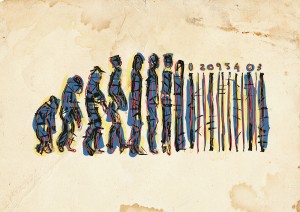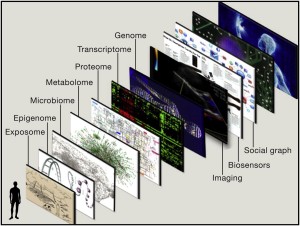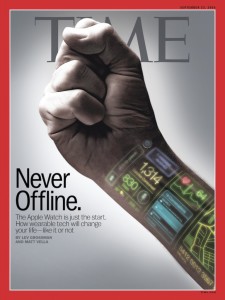Moore’s Law is coming to medicine. And it will look and feel a lot like Uber: with rich technology underpinning, consumer-service oriented and friendly, and shaking up the professionals at the front line of the business (from taxi drivers to physicians).
Eric Topol, physician and editor-in-chief at Medscape, told a standing-room-only audience at the kickoff of the 8th annual Health 2.0 Conference that the democratization of health care is coming based on consumers’ use of eight drivers: sensors, labs, imaging, physical exams, access to medical records, transparency of costs, and digital pills.
 Dr. Topol referred to the cover ot TIME magazine last week, featuring the Apple Watch. While it didn’t have much health loaded onto it, Dr. Topol recognized, this is where we’re headed in medicine. Watches may be getting more fashionable but although you can look at email and calendars, do we really need these things?
Dr. Topol referred to the cover ot TIME magazine last week, featuring the Apple Watch. While it didn’t have much health loaded onto it, Dr. Topol recognized, this is where we’re headed in medicine. Watches may be getting more fashionable but although you can look at email and calendars, do we really need these things?
Only when they have direct impact on health for each consumer, Dr. Topol believes. “When it’s (the smartwatch or other wearable) filled with vital sign monitoring, it becomes critically useful.”
Not far from here (the Santa Clara Convention Center) is Elizabeth Holmes who dropped out of Stanford and has innovated how to use a drop of blood to do dozens of lab tests through her company, Theranos, Dr.Topol said. “The CEO of UCSF Medical Center says this is the huge transformation of health care in front of us.”
Now, Dr. Topol believes, “you can do almost every lab test from a smartphone…almost any radioimmunoassay from the Hologic platform…testosterone measuring from Qloudlab…almost any test will be available via smartphone for a tiny fraction of the price,” Dr. Topol foresees.
Imaging, too, is getting much cheaper, more mobile and accessible. High resolution ultrasound is as good as a $350,000 hospital-based machine. A study published last week in the JACC concluded that the new-new high res modality is better and cheaper, saving $63 per patient visit. This is “far better than the 200-year-old stethoscope but also saves significant cost…there are 125 mm ultraounds done every year,” Dr.Topol shared implying, “do the math.”
Similarly, one can convert a smartphone into an otoscope and exam the entire oral cavity via O Scan from Stanford, perform Peek eye care everywhere, and use an Eye-Phone to do a complete exam through a smartphone.
This talk was a taste of Dr. Topol’s new book due out by the end of the year called The Patient Will See You Now, which follows up his successful work, The Creative Destruction of Medicine.
I will cover the results of the WebMD-Medscape survey of consumers and physicians in the next Health Populi, straight from Health 2.0 in Silicon Valley taking place 21-24 September 2014.






 I'm in amazing company here with other #digitalhealth innovators, thinkers and doers. Thank you to Cristian Cortez Fernandez and Zallud for this recognition; I'm grateful.
I'm in amazing company here with other #digitalhealth innovators, thinkers and doers. Thank you to Cristian Cortez Fernandez and Zallud for this recognition; I'm grateful. Jane was named as a member of the AHIP 2024 Advisory Board, joining some valued colleagues to prepare for the challenges and opportunities facing health plans, systems, and other industry stakeholders.
Jane was named as a member of the AHIP 2024 Advisory Board, joining some valued colleagues to prepare for the challenges and opportunities facing health plans, systems, and other industry stakeholders.  Join Jane at AHIP's annual meeting in Las Vegas: I'll be speaking, moderating a panel, and providing thought leadership on health consumers and bolstering equity, empowerment, and self-care.
Join Jane at AHIP's annual meeting in Las Vegas: I'll be speaking, moderating a panel, and providing thought leadership on health consumers and bolstering equity, empowerment, and self-care.